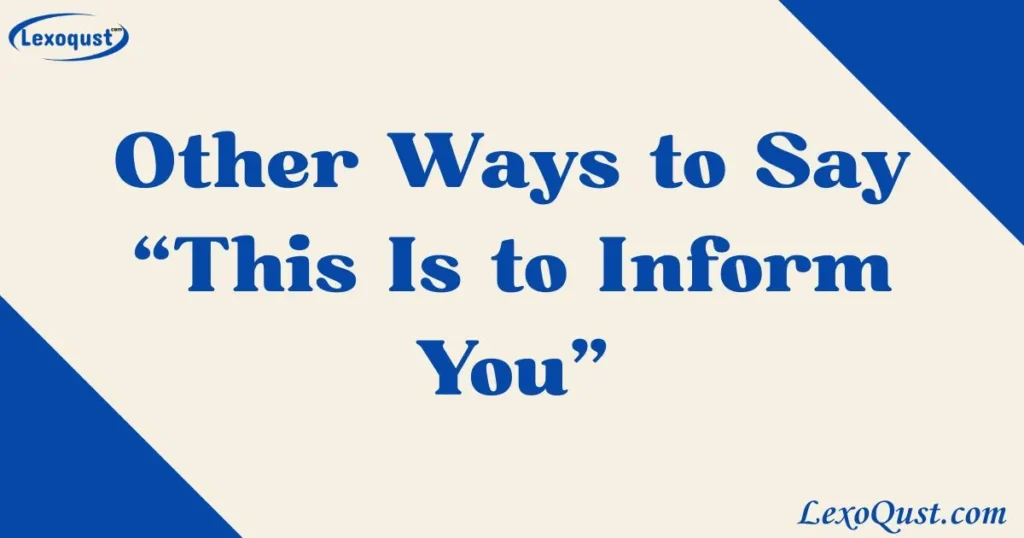In effective communication, every word matters especially in a professional setting. Whether you’re sending an email, making an announcement, or offering important information, how you phrase your message can shape its impact.
The commonly used phrase “This is to inform you”, while clear, can often feel rigid or impersonal. Choosing the right words helps messages sound more personal, convey a tone that resonates, and build positive relationships.
In this guide, you’ll discover 33 alternative phrases that bring warmth and care to your writing, helping you express yourself in a more professional and thoughtful manner while achieving clarity and engaging communication.
What Does “This Is to Inform You” Mean?
“This is to inform you” is a formal phrase used to introduce important information, typically in business or official communication. It signals that the following message contains something the reader needs to know, often in a direct, no-frills tone.
When to Use “This Is to Inform You”
Use this phrase when delivering official updates, notifications, or decisions such as policy changes, approvals, or formal announcements. It’s appropriate for professional settings where clarity and directness are essential.
Is It Professional/Polite to Say “This Is to Inform You”?
Yes, it is professional and polite, though it can come across as stiff or impersonal. To add warmth and care, consider alternatives like “I’d like to inform you” or “Just a quick note to share that…” phrases that balance formality with a more engaging tone.
1. “Here’s Something You Should Know…”
Meaning: Signals that the writer is about to share relevant or helpful information.
Definition: A conversational phrase used to introduce important or noteworthy content.
Tone: Informal, friendly, and direct.
Example: Here’s something you should know before the meeting tomorrow.
Explanation: This phrase engages the reader while offering valuable input, making the message feel intentional and helpful.
Purpose and Personalization: Best for casual or semi-formal communication; can be softened further by adding context like, “Just in case it helps…”
2. “I Wanted to Let You In On…”
Meaning: Suggests the reader is being included in something valuable or exclusive.
Definition: A friendly way to share inside knowledge or updates.
Tone: Personal, inclusive, and warm.
Example: I wanted to let you in on the upcoming changes to our schedule.
Explanation: Makes the reader feel like part of the loop, building trust and rapport.
Purpose and Personalization: Use in newsletters or team messages; adjust tone with emojis or direct names for extra warmth.
3. “In Case You Missed It…”
Meaning: Brings attention to information that may have been overlooked.
Definition: A gentle reminder or recap for the reader’s benefit.
Tone: Considerate, casual, and helpful.
Example: In case you missed it, the deadline has been extended.
Explanation: This phrase is effective for keeping everyone aligned without sounding pushy.
Purpose and Personalization: Great for email follow-ups or updates—can be made more personal with “I thought of you when…”
4. “This Might Be Useful for You…”
Meaning: Introduces helpful information tailored to the reader’s interests.
Definition: A subtle, polite way to offer insights or resources.
Tone: Supportive, kind, and thoughtful.
Example: This might be useful for you as you plan your trip.
Explanation: Adds value without pressure, showing attentiveness to the reader’s needs.
Purpose and Personalization: Works well in professional and personal writing; adapt by specifying how or why it may help.
5. “Just Passing Along Some Info…”
Meaning: Indicates that the writer is sharing something casually and without obligation.
Definition: A relaxed way to forward information or updates.
Tone: Easygoing, informal, and low-pressure.
Example: Just passing along some info about the office hours next week.
Explanation: Reduces formality and keeps communication open and accessible.
Purpose and Personalization: Ideal for team chats or casual updates—customize with a short intro or link to the source.
6. “I Wanted to Make You Aware of…”
Meaning: Politely alerts the reader to something important or timely.
Definition: A courteous introduction to relevant information.
Tone: Respectful, informative, and professional.
Example: I wanted to make you aware of a policy change affecting your department.
Explanation: Shows consideration for the reader while maintaining professionalism.
Purpose and Personalization: Use in formal emails or notices; adapt with softer language for a friendlier tone.
7. “Just So You Know…”
Meaning: Shares helpful information in a relaxed, conversational way.
Definition: Used to gently provide context or updates.
Tone: Casual, transparent, and informative.
Example: Just so you know, the meeting time has changed.
Explanation: Keeps readers informed without sounding formal or cold.
Purpose and Personalization: Works best in casual messages—can be paired with friendly emojis or informal phrasing.
8. “I’d Like to Bring to Your Attention…”
Meaning: Highlights something the reader should focus on.
Definition: A formal way of flagging important information.
Tone: Serious, direct, and professional.
Example: I’d like to bring to your attention the recent update to our privacy policy.
Explanation: Encourages action or awareness in a respectful way.
Purpose and Personalization: Suitable for formal reports or memos; adjust by softening the tone in less rigid contexts.
9. “Please Be Informed That…”
Meaning: Officially shares a fact or decision.
Definition: A formal notification phrase used in business communication.
Tone: Authoritative, formal, and clear.
Example: Please be informed that the system will be down for maintenance this weekend.
Explanation: Establishes clarity and formality, leaving little room for misinterpretation.
Purpose and Personalization: Ideal for policy notices—can be made more reader-friendly by adding context or reasoning.
10. “I Would Like to Notify You…”
Meaning: Introduces a message with formality and intent.
Definition: A structured way to begin delivering key information.
Tone: Polite, official, and courteous.
Example: I would like to notify you of a pending schedule adjustment.
Explanation: Establishes a clear, respectful tone right from the start.
Purpose and Personalization: Works well in professional contexts; personalize by briefly explaining the reason for the message.
11. “It’s Important to Note That…”
Meaning: Emphasizes the significance of the following message.
Definition: A transitional phrase that signals critical information.
Tone: Assertive, clear, and informative.
Example: It’s important to note that fees will apply after this date.
Explanation: Helps readers identify key points they shouldn’t overlook.
Purpose and Personalization: Useful in guidelines or instructions; can be softened by using “just a reminder” before.
12. “I Want to Ensure You’re Aware of…”
Meaning: Confirms the reader is informed to avoid confusion or oversight.
Definition: A proactive, caring way to prevent misunderstandings.
Tone: Thoughtful, reassuring, and clear.
Example: I want to ensure you’re aware of the recent updates to the contract.
Explanation: Shows responsibility and care in communication.
Purpose and Personalization: Adapt by using “just to help keep things clear…” in friendlier contexts.
13. “Just a Heads-Up…”
Meaning: Offers a quick, informal warning or notice.
Definition: A casual way to give advance notice or tip.
Tone: Relaxed, friendly, and alerting.
Example: Just a heads-up—we may need to reschedule the call.
Explanation: Lowers pressure while still sharing useful information.
Purpose and Personalization: Ideal for peer or team communication; add a smiley or brief reasoning for clarity.
14. “I’m Writing to Inform You That…”
Meaning: Introduces the purpose of a formal written message.
Definition: A straightforward, business-like phrase.
Tone: Professional, structured, and formal.
Example: I’m writing to inform you that your request has been approved.
Explanation: Immediately sets a respectful and informative tone.
Purpose and Personalization: Best in official letters or emails—adjust tone by using “just wanted to let you know” for casual updates.
15. “I’d Like to Share with You That…”
Meaning: Opens the message with a tone of inclusion and care.
Definition: A warm alternative to more rigid notification phrases.
Tone: Friendly, considerate, and professional.
Example: I’d like to share with you that our new initiative launches next week.
Explanation: Encourages a more personal, engaged response from the reader.
Purpose and Personalization: Use when building rapport—customize with enthusiasm or reader-focused benefits.
16. “I Wanted to Update You On…”
Meaning: Indicates that you’re following up with current information.
Definition: A phrase that introduces new or developing details.
Tone: Helpful, timely, and informative.
Example: I wanted to update you on the progress of the redesign.
Explanation: Keeps the reader informed without sounding too formal.
Purpose and Personalization: Use in ongoing correspondence; personalize by linking to past conversations or updates.
17. “I Would Like to Update You That…”
Meaning: A formal variant for relaying recent changes or decisions.
Definition: Used to share progress or status updates.
Tone: Courteous, formal, and informative.
Example: I would like to update you that your documents have been submitted.
Explanation: Maintains professionalism while keeping communication current.
Purpose and Personalization: Ideal in project updates; can be made warmer with phrases like “Glad to inform…”
18. “I Thought You Should Know…”
Meaning: Shares something the writer believes is relevant to the reader.
Definition: A casual expression that conveys importance with care.
Tone: Friendly, thoughtful, and sincere.
Example: I thought you should know there’s been a change in our plan.
Explanation: Strengthens trust and openness in communication.
Purpose and Personalization: Works well in personal and team emails; tailor with “because it might affect you…”
19. “Please Take Note of…”
Meaning: Requests the reader’s attention on a specific detail.
Definition: A polite command that emphasizes importance.
Tone: Direct, respectful, and informative.
Example: Please take note of the new submission deadline.
Explanation: Prevents missed information by clearly signaling what’s essential.
Purpose and Personalization: Perfect for reminders or bulletins; use “just a quick note” for softer delivery.
20. “Allow Me to Inform You…”
Meaning: Introduces the act of formally sharing news or updates.
Definition: A refined and respectful phrase.
Tone: Formal, polite, and composed.
Example: Allow me to inform you that your request has been reviewed.
Explanation: Suitable for ceremonial or structured communication.
Purpose and Personalization: Useful in formal letters; personalize by using “happy to share” for a lighter tone.
21. “I Just Wanted to Make You Aware…”
Meaning: Gently introduces information you believe the reader should know.
Definition: A softer, more conversational way to share updates or concerns.
Tone: Considerate, informal, and approachable.
Example: I just wanted to make you aware of a delay in shipping.
Explanation: Builds a friendly tone while still offering necessary information.
Purpose and Personalization: Great for casual emails or customer updates—adjust tone by including empathy or context.
22. “Just Wanted to Let You Know…”
Meaning: Provides information in a relaxed, informal tone.
Definition: An easygoing phrase used to introduce a message.
Tone: Friendly, conversational, and supportive.
Example: Just wanted to let you know the team will be working remotely next week.
Explanation: Keeps things simple and human, promoting connection.
Purpose and Personalization: Ideal for everyday updates—can be personalized with the recipient’s name or shared interest.
23. “Please Be Advised…”
Meaning: Formally brings the reader’s attention to a fact or decision.
Definition: A directive statement used in official or legal writing.
Tone: Formal, authoritative, and informative.
Example: Please be advised that your account will be suspended unless updated.
Explanation: Conveys seriousness and clarity, ensuring the message is understood.
Purpose and Personalization: Best in legal or policy-related content; soften by pairing with a reason or context.
24. “I Would Like to Bring to Your Awareness…”
Meaning: Introduces new or overlooked information thoughtfully.
Definition: A respectful way to make someone aware of an issue or fact.
Tone: Professional, composed, and informative.
Example: I would like to bring to your awareness the recent system change.
Explanation: Encourages mindful communication while respecting the reader.
Purpose and Personalization: Suitable for workplace communication—add warmth by expressing concern or appreciation.
25. “I’m Reaching Out to Let You Know…”
Meaning: Initiates contact to provide meaningful updates or insight.
Definition: A courteous way to start a message that shares information.
Tone: Warm, intentional, and thoughtful.
Example: I’m reaching out to let you know your request has been approved.
Explanation: Establishes a personal connection and purpose from the start.
Purpose and Personalization: Works well in customer service or networking—customize with “personally” or a shared reference.
26. “This Is to Notify You…”
Meaning: Clearly states that the purpose is to deliver a formal message.
Definition: A professional phrase for official notifications.
Tone: Formal, neutral, and direct.
Example: This is to notify you of a change in your account terms.
Explanation: Delivers clear intent, often used in institutional or legal contexts.
Purpose and Personalization: Ideal for formal communication; humanize by adding context or next steps.
27. “Please Be Aware…”
Meaning: Politely emphasizes awareness of upcoming or ongoing matters.
Definition: A gentle prompt that informs without sounding demanding.
Tone: Considerate, informative, and neutral.
Example: Please be aware that site access will be limited this weekend.
Explanation: Encourages readiness without pressure.
Purpose and Personalization: Perfect for client or staff communication—customize with suggestions or helpful links.
28. “Just To Keep You Updated…”
Meaning: Provides new information in an ongoing conversation.
Definition: A light, friendly way to continue sharing relevant details.
Tone: Supportive, casual, and informative.
Example: Just to keep you updated, the team has finalized the design phase.
Explanation: Keeps the reader engaged without overwhelming them.
Purpose and Personalization: Ideal for project updates—add a note of appreciation to personalize.
29. “I Would Like to Make You Aware…”
Meaning: Politely introduces significant news or concerns.
Definition: A professional way of sharing important updates.
Tone: Courteous, professional, and respectful.
Example: I would like to make you aware of the following procedural changes.
Explanation: Establishes thoughtful communication with a formal tone.
Purpose and Personalization: Suitable for formal updates—soften with “so you’re not caught off guard…”
30. “I Hope This Information Finds You Well…”
Meaning: Introduces a message with warmth and consideration.
Definition: A kind and polite lead-in to sharing information.
Tone: Warm, caring, and gentle.
Example: I hope this information finds you well and helps with your preparation.
Explanation: Sets a respectful tone that values the reader.
Purpose and Personalization: Use in personal or professional notes—adapt with the reader’s name or specific context.
31. “Please Allow Me to Update You…”
Meaning: Requests the reader’s attention for new developments.
Definition: A polite way to offer recent updates or corrections.
Tone: Formal, respectful, and thoughtful.
Example: Please allow me to update you on the current project status.
Explanation: Maintains professionalism while signaling care.
Purpose and Personalization: Useful in formal communication—add gratitude or enthusiasm for a personal touch.
32. “I Wanted to Give You a Quick Update…”
Meaning: Shares brief and relevant news with minimal disruption.
Definition: A concise introduction to a short, informative message.
Tone: Friendly, efficient, and clear.
Example: I wanted to give you a quick update on the event schedule.
Explanation: Respects the reader’s time while keeping them informed.
Purpose and Personalization: Great for busy readers—personalize with “before the weekend” or “as promised.”
33. “For Your Information…”
Meaning: Introduces details that may be useful but don’t require action.
Definition: A neutral phrase used to pass along reference-worthy info.
Tone: Informative, straightforward, and objective.
Example: For your information, the team has decided to extend the timeline.
Explanation: Offers facts in a way that leaves action optional.
Purpose and Personalization: Best in memos or briefs—make friendlier by adding why it might matter to the reader.
34. “I Just Wanted to Keep You in the Loop…”
Meaning: Expresses intent to include the reader in ongoing developments.
Definition: A casual, friendly phrase to provide updates.
Tone: Inclusive, approachable, and open.
Example: I just wanted to keep you in the loop about our progress.
Explanation: Fosters connection by maintaining transparency.
Purpose and Personalization: Great for team or partner updates—personalize by mentioning their role or interest.
35. “This Is To Keep You Informed…”
Meaning: Emphasizes the goal of sharing knowledge or updates.
Definition: A neutral phrase for passing on relevant details.
Tone: Professional, informative, and objective.
Example: This is to keep you informed of our current policy regarding refunds.
Explanation: Signals transparency and supports clarity.
Purpose and Personalization: Suitable for newsletters or bulletins customize with reader benefits or next steps.
Conclusion
Choosing the right words can transform your message from generic to genuine. Replacing phrases like “This is to inform you” with more personalized, thoughtful alternatives enhances clarity, builds positive relationships, and strengthens your voice in any setting be it an academic paper, professional email, or personal letter.
I encourage you to apply these alternative phrases and let your writing reflect your unique tone and intent. Every word holds power, use it wisely. I hope this guide becomes a valuable tool for your journey toward more engaging communication and meaningful expression.

Hi! I’m Amelia Ashford, the admin of Lexoqust.com. Here, we dive deep into the world of synonyms to help you express yourself better.From everyday words to advanced vocabulary, Lexoqust makes your writing richer and more refined.



